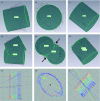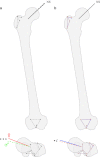A three-dimensional axis for the study of femoral neck orientation
- PMID: 22967192
- PMCID: PMC3482355
- DOI: 10.1111/j.1469-7580.2012.01565.x
A three-dimensional axis for the study of femoral neck orientation
Abstract
A common problem in the quantification of the orientation of the femoral neck is the difficulty to determine its true axis; however, this axis is typically estimated visually only. Moreover, the orientation of the femoral neck is commonly analysed using angles that are dependent on anatomical planes of reference and only quantify the orientation in two dimensions. The purpose of this study is to establish a method to determine the three-dimensional orientation of the femoral neck using a three-dimensional model. An accurate determination of the femoral neck axis requires a reconsideration of the complex architecture of the proximal femur. The morphology of the femoral neck results from both the medial and arcuate trabecular systems, and the asymmetry of the cortical bone. Given these considerations, two alternative models, in addition to the cylindrical one frequently assumed, were tested. The surface geometry of the femoral neck was subsequently used to fit one cylinder, two cylinders and successive cross-sectional ellipses. The model based on successive ellipses provided a significantly smaller average deviation than the two other models (P < 0.001) and reduced the observer-induced measurement error. Comparisons with traditional measurements and analyses on a sample of 91 femora were also performed to assess the validity of the model based on successive ellipses. This study provides a semi-automatic and accurate method for the determination of the functional three-dimensional femoral neck orientation avoiding the use of a reference plane. This innovative method has important implications for future studies that aim to document and understand the change in the orientation of the femoral neck associated with the acquisition of a bipedal gait in humans. Moreover, the precise determination of the three-dimensional orientation has implications in current research involved in developing clinical applications in diagnosis, hip surgery and rehabilitation.
© 2012 The Authors Journal of Anatomy © 2012 Anatomical Society.
Figures






References
-
- Baylac M. Rmorph a morphometric library for R. 2010. Available from the author: baylac(at)mnhn.fr [accessed 1 January 2010]
-
- Beck TJ, Ruff CB, Scott WW, et al. Sex differences in geometry of the femoral neck with aging: a structural analysis of bone mineral data. Calcif Tiss Intl. 1992;50:24–29. - PubMed
-
- Bonneau N, Simonis C, Seringe R, et al. Study of femoral torsion during prenatal growth: interpretation associated with the effects of intrauterine pressure. Am J Phys Anthropol. 2011;145:438–445. - PubMed
-
- Bookstein FL. Morphometric Tools for Landmark Data (Geometry and Biology) Cambridge: Cambridge University Press; 1991.
Publication types
MeSH terms
LinkOut - more resources
Full Text Sources

